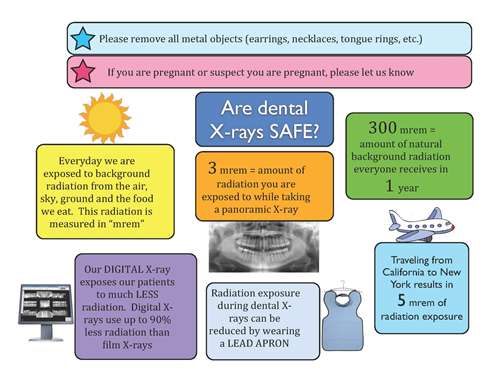Why are dental x-ray exams needed?
X-ray images, also called radiographs, help the dentist find problems that are not visible during an oral examination.
An x-ray exam may help the dentist see:
- beginning cavities between the teeth.
- recurring decay under existing restorations
- a tooth infection (such as an abscess), or a cyst in the jaw.
- extra teeth
- missing teeth
- upside-down teeth
- impacted teeth.
- some types of tumors
- the position of unerupted teeth (teeth that have not come in yet).
Why do we take digital images?
Our pediatric dental practice uses digital x-rays to help us take care of your children’s oral health. The x-ray machines we use are filmless, fast and easy for the children, and make very clear pictures that are stored electronically.
There are many benefits to using digital dental images.
- The image can be sent directly to the patient’s electronic dental record and viewed chair-side immediately.
- The images can be enlarged or enhanced for better diagnostic clarity
- The images can be sent electronically to insurance companies, which may help claims be processed faster.
- The images can be printed for you to take home.
- Digital imaging is environmentally friendly. We do not use film or chemicals to process the film. Instead, we use electronic sensors similar to modern cameras.
- Digital images require much less radiation compared to film images.
Are dental x-rays safe for my child?
Digital images require very low levels of radiation. The levels are similar to the amount of radiation we all get from space and the earth in a day or two. (see diagram below).

We use special precautions to lessen our patients to radiation exposure including:
- Taking images only when indicated. (We follow the guidelines prescribed by The American Academy Of Pediatric Dentistry and the American Dental Association.
- Keeping the size of the x-ray beam as small as possible and aiming the beam carefully.
- Covering as much of the body as possible with a protective lead apron.